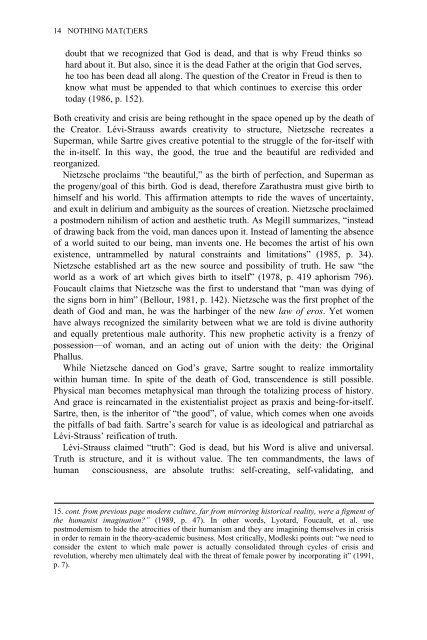Nothing Mat(t)ers: A Feminist Critique of Postmodernism
Nothing Mat(t)ers: A Feminist Critique of Postmodernism
Nothing Mat(t)ers: A Feminist Critique of Postmodernism
You also want an ePaper? Increase the reach of your titles
YUMPU automatically turns print PDFs into web optimized ePapers that Google loves.
14 NOTHING MAT(T)ERS<br />
doubt that we recognized that God is dead, and that is why Freud thinks so<br />
hard about it. But also, since it is the dead Father at the origin that God serves,<br />
he too has been dead all along. The question <strong>of</strong> the Creator in Freud is then to<br />
know what must be appended to that which continues to exercise this order<br />
today (1986, p. 152).<br />
Both creativity and crisis are being rethought in the space opened up by the death <strong>of</strong><br />
the Creator. Lévi-Strauss awards creativity to structure, Nietzsche recreates a<br />
Superman, while Sartre gives creative potential to the struggle <strong>of</strong> the for-itself with<br />
the in-itself. In this way, the good, the true and the beautiful are redivided and<br />
reorganized.<br />
Nietzsche proclaims “the beautiful,” as the birth <strong>of</strong> perfection, and Superman as<br />
the progeny/goal <strong>of</strong> this birth. God is dead, therefore Zarathustra must give birth to<br />
himself and his world. This affirmation attempts to ride the waves <strong>of</strong> uncertainty,<br />
and exult in delirium and ambiguity as the sources <strong>of</strong> creation. Nietzsche proclaimed<br />
a postmodern nihilism <strong>of</strong> action and aesthetic truth. As Megill summarizes, “instead<br />
<strong>of</strong> drawing back from the void, man dances upon it. Instead <strong>of</strong> lamenting the absence<br />
<strong>of</strong> a world suited to our being, man invents one. He becomes the artist <strong>of</strong> his own<br />
existence, untrammelled by natural constraints and limitations” (1985, p. 34).<br />
Nietzsche established art as the new source and possibility <strong>of</strong> truth. He saw “the<br />
world as a work <strong>of</strong> art which gives birth to itself” (1978, p. 419 aphorism 796).<br />
Foucault claims that Nietzsche was the first to und<strong>ers</strong>tand that “man was dying <strong>of</strong><br />
the signs born in him” (Bellour, 1981, p. 142). Nietzsche was the first prophet <strong>of</strong> the<br />
death <strong>of</strong> God and man, he was the harbinger <strong>of</strong> the new law <strong>of</strong> eros. Yet women<br />
have always recognized the similarity between what we are told is divine authority<br />
and equally pretentious male authority. This new prophetic activity is a frenzy <strong>of</strong><br />
possession—<strong>of</strong> woman, and an acting out <strong>of</strong> union with the deity: the Original<br />
Phallus.<br />
While Nietzsche danced on God’s grave, Sartre sought to realize immortality<br />
within human time. In spite <strong>of</strong> the death <strong>of</strong> God, transcendence is still possible.<br />
Physical man becomes metaphysical man through the totalizing process <strong>of</strong> history.<br />
And grace is reincarnated in the existentialist project as praxis and being-for-itself.<br />
Sartre, then, is the inheritor <strong>of</strong> “the good”, <strong>of</strong> value, which comes when one avoids<br />
the pitfalls <strong>of</strong> bad faith. Sartre’s search for value is as ideological and patriarchal as<br />
Lévi-Strauss’ reification <strong>of</strong> truth.<br />
Lévi-Strauss claimed “truth”: God is dead, but his Word is alive and univ<strong>ers</strong>al.<br />
Truth is structure, and it is without value. The ten commandments, the laws <strong>of</strong><br />
human consciousness, are absolute truths: self-creating, self-validating, and<br />
15. cont. from previous page modern culture, far from mirroring historical reality, were a figment <strong>of</strong><br />
the humanist imagination” (1989, p. 47). In other words, Lyotard, Foucault, et al. use<br />
postmodernism to hide the atrocities <strong>of</strong> their humanism and they are imagining themselves in crisis<br />
in order to remain in the theory-academic business. Most critically, Modleski points out: “we need to<br />
consider the extent to which male power is actually consolidated through cycles <strong>of</strong> crisis and<br />
revolution, whereby men ultimately deal with the threat <strong>of</strong> female power by incorporating it” (1991,<br />
p. 7).

















